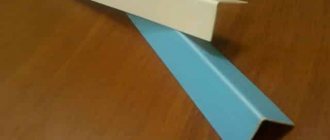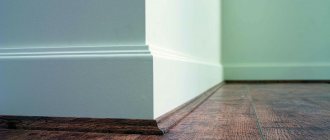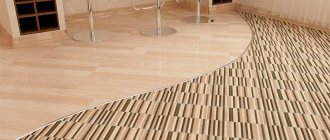Advantages, disadvantages
Advantages:
- They mask corner joints well.
- Covers minor surface irregularities.
- Lifetime.
- Installation does not require knowledge, just trim the corners correctly.
- Large palette.
- Compared to aluminum, plastic is cheaper.
Flaws:
- Due to the fragility of PVC, accidental damage to elements during cutting is likely. Sometimes the cuttings have to be thrown away.
- During a fire, harmful substances are released. Decorating evacuation areas is not recommended by fire services.
Kinds
The decorative corner is divided into types, depending on the material:
- Metal. Purpose – strengthening the corner structure. Can be found on plasterboard structures.
Metal
- Wood. Often used on installed timber windows to create a cohesive look. It is possible to select a wooden element to match the pasted wallpaper.
Wood
- Plastic. The most common type. The advantage is that you can choose the color of the fittings to match the interior. The laminated surface imitates other materials.
Plastic
General information
Types of plastic profiles
Plastic profiles can be used as finishing for exterior use, arched, tiled, ceiling, bathroom, decorative, furniture, for framing doors and window openings.
Based on their design features, profiles are divided into:
- with a rigid structure;
- with flexible.
Products with rigid structure
Presented in the form of classic rectangular profiles. Such profiles are made in a way that involves longitudinal bending of PVC plates. This is done when exposed to high temperatures.
The outside of the corner can have a matte or glossy surface, in a variety of colors. The size range is from 2600 to 3000 mm in length, and the size of the shelves is from 10 to 100 mm. They also produce multi-shelf corners, called arched corners. They have the ability to bend along the desired radius.
Products with a rigid structure are used for 90-degree angles, as well as for finishing window openings, wall transitions, and serve as protection for wallpaper coverings.
Soft
Presented in the form of plastic strips with a longitudinal recess in the center, thanks to which the material is able to bend at the desired angle. They can be in any color scheme, and also have a decorative film. Universal profiles are produced in the form of coils of 50 m, and the size of the shelves ranges from 10 to 100 mm. In case of large deviations from the right angle, corners with a flexible profile are used.
Where is it used?
Plastic corners are used for various jobs. Performs decorative and practical functions.
- Execution in colored tones - decoration of windows and doors.
- With plasterboard structures, it is more logical to use metal elements. Structures require mandatory treatment with plaster mixtures. Metal fittings will further strengthen the structure.
- Wooden and plastic elements are attached to wallpapered walls.
- Corner connections can be internal or external.
Classification
There are a lot of PVC fittings on the building materials market.
- The most common ones are with sides of equal width 2x2, 5x5cm.
- A material with asymmetrical sides is often used to decorate arched openings. The common size is 10x20mm.
- T, F-shaped. They are used to mask the joining elements of the opening and wall slopes.
- Elements on the latch. Installation is more convenient and several times faster.
Dimensions
They vary in length (2m 60cm – 3m), width (1cm – 10cm).
Dimensions
Application:
- When installing an arched opening, planks with asymmetrical sides (5x17, 10x20, 15x25 mm) will help.
- If you need to join two surfaces and disguise a seam, a T-shaped element (12x10, 18x10, 20x10 and 22x10mm) is suitable.
- To strengthen the slope, you will need wide products (20x20, 50x50mm).
- For the window opening - strips 10x10, 15x15mm.
Peculiarities
Thanks to its qualities, the material has become popular and is in great demand:
- Used as a concealer. After finishing the slope it forms a right angle.
- With proper use it will last a long time. The operational period is tens of years.
- Anyone can handle the installation of the element, even without experience.
- High moisture resistance.
- Does not rot or form mold. Can be installed in rooms with high humidity.
- Helps create even angles on plastered surfaces.
- Metal fittings strengthen the structure.
- Products made of wood, plastic, metal do not harm health and do not emit aggressive substances into the atmosphere.
- Due to its low weight, the construction of window and door openings will not be loaded.
- Resistance to mechanical damage. When exposed to sharp objects, minor scratches remain; these can be removed by sanding the surface.
- Not prone to decay or change color from exposure to direct sunlight.
The material has some rigidity, but can break under significant mechanical stress. It is not recommended to install plastic corners on the street side, as this increases fragility.
Do not place plastic items near flammable materials or heating equipment. When burned, plastic releases toxic substances.
Types of protective corners: from what materials
According to the area of application, corners are available for external (outdoor) and internal use. For now, let's talk about how to protect corners in an apartment and a house - indoors. Let's start with the materials. Corners for protecting wall corners can be:
- Made of plastic (PVC). Different colors, textures, there are even transparent ones.
- Made of metal. Brass, aluminum (polished and not), stainless steel, with or without painting.
- Wooden. Made from different types of wood, smooth, with relief.
The corner on the arch is covered with a flexible plastic corner
- MDF. With imitation of various types of wood, smoothly painted, with various patterns.
- From a traffic jam. It could be an interesting move to add cork trim to more than just the corners.
Cork corners to protect corners
- Rubber. Typically used in hospitals or kindergartens. Perfect for protecting corners in the garage.
- Foamed rubber. Same as rubber ones, but softer. Suitable for protecting overly active children from injury.
- Decorative - with carvings, rhinestones, patterns, etc.
The most popular are plastic corners for protecting wall corners. Don’t think that such protection looks poor. In any case, no worse than frayed corners. It’s just that there are different types of plastic – polished, with a metallic effect, with a satin (matte) surface, with different reliefs. It is clear that in order to find something specific or special, you will have to run around construction stores and markets. But there are many types of design. If the corners for protecting the corners of the walls are chosen correctly, they fit organically into the design without attracting attention at all. At the same time, they protect and decorate the joints very reliably.
Glue selection
Before installation, you need to select adhesive. Polyurethane will do.
There is often advice about sticking a plastic corner onto silicone sealant. Over time, the sealant turns yellow, becomes covered with a dark coating, and requires replacement of the adhesive composition.
The “liquid nails” composition has proven itself quite well. Universal, suitable for different surfaces. Crazy glue is often used. The composition sticks very well.
The choice of adhesive base depends on the parameters of the surfaces to be glued.
Installation of plastic corners on slopes
In the case of a standard installation, the adhesive mass is applied to the inner surface of the product. The exception is elements with a latch. Installation is simple, the disadvantage is that dismantling is impossible.
Installation of corners is carried out after completion of finishing work.
Preparatory activities
Preparatory work:
- If installing fittings on an untreated surface, carry out a preliminary check for protrusions, potholes, and protruding nails. For maximum adhesion, you need to achieve a flat surface.
- When working with some surfaces, before installation it is necessary to degrease and wipe the corner from dirt.
- Take measurements of the window opening. When measuring, take into account small overlaps so that when cutting the connection, gaps do not form. The recommended overlap length is 1 – 5 mm.
- When cutting off parts, you don’t need to cut the corners right away; it’s better to do it locally.
Docking options:
- By overlapping each other. The resulting difference is covered with sealant to match the color of the material.
- Trimming a corner joint. Looks nicer, requires skill.
The plastic is cut with a utility knife. A blunt instrument may damage the product.
Installation
After thorough preparation of surfaces and materials, you can proceed to installation work.
- Installation can be started from any side.
- Take the corner, turn it wrong side out, and apply glue. The method of applying the glue (dotted, dotted, solid line) is not important. If you need to save the adhesive mixture, spot application will help.
The glue should be applied closer to the corner part for a stronger fixation of the element.
- The workpiece is placed on the surface and pressed. Excess adhesive that appears must be removed immediately. Depending on the adhesive composition, different cleaning agents are used. The most common, suitable for almost all mixtures, is white spirit.
- Additional fixation with masking tape will be required. This is a temporary measure and must be removed after the glue has hardened.
Adhesive tape
- Installation is carried out around the perimeter of the opening.
- After 24 hours, the masking tape is removed.
Installation of plastic corners is simple, but cutting requires skill. The main thing is to be careful, to maintain accuracy in calculations and trimming.
Main types of corner and its purpose
L-profile has two main subtypes: Starting, universal L-profile;
Purpose:
- Performs the function of a groove for a PVC panel and is attached in the area where it adjoins the window or doorway;
- Covers the end sides of the slopes;
- An edging or decorative L-profile is used for the corner connection of two planes.
U-profile, installed at the preparatory stage of installation of slopes.
Purpose:
- Framing and decorating slopes;
- Protection of external corners from mechanical damage;
- Masking of loose panel joints and gaps.
F-profile. Thanks to the additional jumper, it can be easily mounted on the ends of PVC panels without the use of glue. The convenience is that it can be removed if you need to re-glue the wallpaper or carry out other minor repairs in the area of the window opening, and after the work is completed, it can be easily installed back in place.
Purpose:
- Frames and decorates the opening, acting as a platband around the perimeter of the window or door;
- Closes the joint between the PVC panel and the wall.



